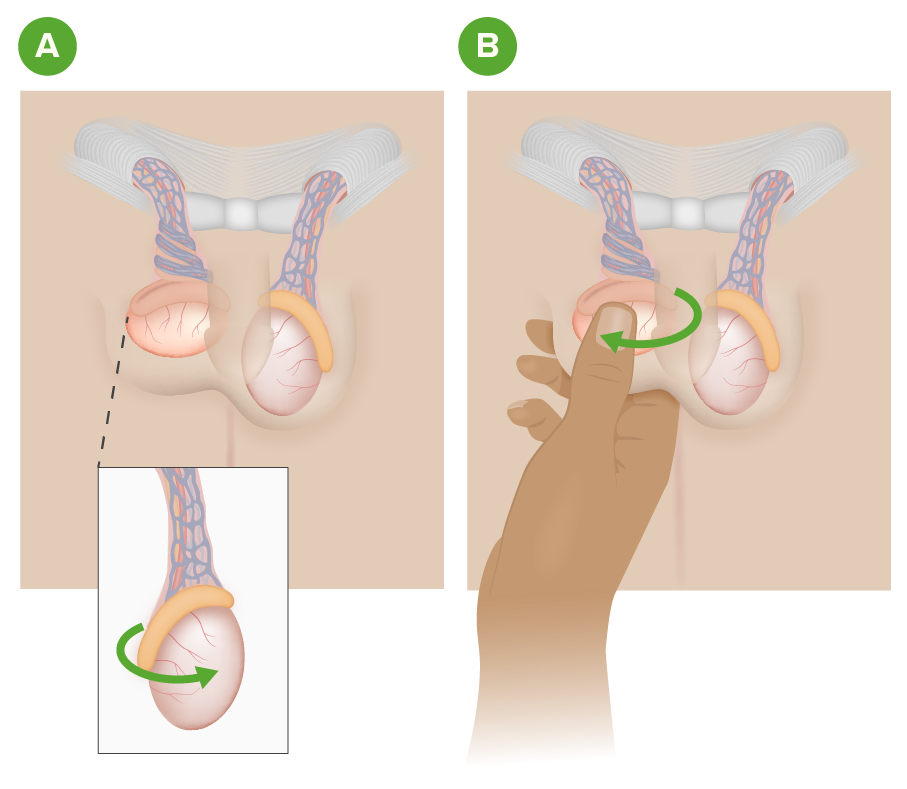Playlist
Show Playlist
Hide Playlist
Testicular Torsion (Emergency Medicine)
-
Emergency Medicine Bord Torsion.pdf
-
Download Lecture Overview
00:01 Hi. We’re gonna be talking about testicular and ovarian torsion. 00:05 We’re gonna get started by talking about testicular torsion. 00:09 Here is a diagram basically your anatomy drawing of the male GU system. 00:15 Testicular torsion just kind of a bit of review of anatomy, so the testicle it’s in the scrotal sac and the blood supply comes down to the testicle via the spermatic cord. 00:27 Now testicular torsion occurs when the testes twist within the tunica vaginalis. 00:34 So when they basically twist upon themselves, the blood supply that goes to the testicle area gets cut off. 00:41 Testicular torsion occurs bimodally. 00:46 So it’s most common in the first year of life and then at the time of puberty. 00:51 But 40% of cases take place in adults. 00:54 It’s more common in the winter months and the reason for that is because the cremasteric muscle contracts due to the colder temperatures and sometimes when that cremasteric muscle contacts, it can cause the testicle to twist upon itself. 01:11 When we’re thinking about testicular torsion, this is one of those things like most cases of ischemia or decrease blood flow so whether it’s ischemia to your heart, ischemia to your bowel, or ischemia to your testicle, time matters. 01:24 So the longer period of time between when this condition develops and when it’s fixed, the less or the lower the rate of salvage. 01:33 And as time goes on, the amount of atrophy can increase. 01:37 The reason that these matters is because the testicles is required for fertility so in order to make sperm and cause a woman to get pregnant we need to make sure that the testicles stays healthy. 01:49 It’s especially important that we treat this as early as possible especially in those younger patients which we know is when the majority of testicular torsion is gonna present because they still have a lifetime ahead of them and are gonna potentially want to reproduce when they get older. 02:05 So time matters here. 02:06 When you're thinking about this, get your consultants involved early. 02:10 Get the patient treatment as rapidly as you can. 02:13 The history here for testicular torsion. 02:17 What are patients gonna tell you? Generally, it’s a sudden onset of testicular pain. 02:22 This distinguishes it from epididymitis which is more of a gradual onset of testicular pain and that’s gonna be one of the other big things on our differential of consequence here, epididymitis. 02:32 Patients may have lower abdominal pain, pain in the inguinal region. 02:36 So just some kind of the groin or the upper thigh region. 02:39 It can often times develop several hours after physical activity but it’s important to know that many patients have a delayed presentation so patients for whatever reason will experience this pain and this discomfort and they won't bring themselves to the emergency department or to their doctor in a rapid fashion. 02:59 So someone might not necessarily run to the hospital right when this happens. 03:03 They may come hours, potentially even days later. 03:09 Some patient may report a history of blunt trauma to the testicles. 03:12 Now these can sometimes throw people off, right? You could think that maybe the testicles hurts due to trauma, but it’s important to know that this can sometimes be almost unrelated to the presentation, so still making sure that when patients come in with these symptoms, the top thing on your differential of consequence is torsion, right? So the top thing that you're thinking about is the thing that needs the most emergent treatment. 03:39 It’s important to remember when we’re thinking about these groups so the most common age groups are very young babies, so less than one year of age. 03:47 And for those patients, they’re potentially at an advantage because they’re getting their diapers changed all the time and in that process the parent or the caretaker may notice that the testicles is swollen. 03:56 Now pubertal patients maybe has incidental reveal that they’re having pain in their testicle. 04:02 They are just sort of coming of age, they may not necessarily know how to express it, they might be embarrassed. 04:06 They might think it’s something that they’ve done. 04:08 So you always wanna ask about testicular pain for all patients presenting with an abdominal pain especially in those pubertal males. 04:16 And have a very low threshold for performing a GU exam on these patients with abdominal pain. 04:23 Especially in the pubertal patient because if you don’t do it and the patient isn’t gonna be forth coming with you or tell you that can be a very big problem for the patient moving forward.
About the Lecture
The lecture Testicular Torsion (Emergency Medicine) by Sharon Bord, MD is from the course Abdominal and Genitourinary Emergencies.
Included Quiz Questions
Why does testicular torsion occur more commonly in winter months?
- Increased cremasteric contraction
- Increased laxity of the cremasteric muscle
- Increased diameter of the spermatic cord
- Increased cremasteric relaxation
- Decreased cremasteric contraction
Which of the following statements regarding the history of patients with testicular torsion is INCORRECT?
- The onset of testicular pain is gradual.
- There is associated lower abdominal pain.
- Pain develops several hours after physical activity.
- Symptoms may have a delayed presentation.
- Patients may have history of blunt trauma to the testicle.
Customer reviews
5,0 of 5 stars
| 5 Stars |
|
5 |
| 4 Stars |
|
0 |
| 3 Stars |
|
0 |
| 2 Stars |
|
0 |
| 1 Star |
|
0 |




